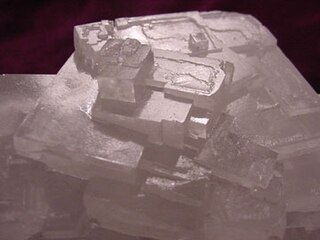 W
WHalide minerals are those minerals with a dominant halide anion. Complex halide minerals may also have polyatomic anions.
 W
WAbhurite is a mineral of tin, oxygen, hydrogen, and chlorine with the formula Sn21O6(OH)14Cl16 or Sn3O(OH)2Cl2. It is named after its type locality, a shipwreck with tin ingots at Sharm Abhur, a cove near Jeddah in the Red Sea. Abhurite forms alongside other tin minerals like romarchite and cassiterite.
 W
WAkaganeite, also written as the deprecated Akaganéite, is a chloride-containing iron(III) oxide-hydroxide mineral, formed by the weathering of pyrrhotite (Fe1−xS).
 W
WAnthonyite is a hydrous secondary copper halide mineral with chemical formula of Cu(OH,Cl)2•3(H2O).
 W
WApatite is a group of phosphate minerals, usually referring to hydroxyapatite, fluorapatite and chlorapatite, with high concentrations of OH−, F− and Cl− ions, respectively, in the crystal. The formula of the admixture of the three most common endmembers is written as Ca10(PO4)6(OH,F,Cl)2, and the crystal unit cell formulae of the individual minerals are written as Ca10(PO4)6(OH)2, Ca10(PO4)6F2 and Ca10(PO4)6Cl2.
 W
WAsisite (Pb7SiO8Cl2) is a yellow tetragonal mineral. It is found at Kombat Mine, Kombat, Grootfontein District, Otjozondjupa Region, Namibia. It was named for a farm, Asis, which covers the mine where it was found. It was discovered in 1988.
 W
WAtacamite is a copper halide mineral: a copper(II) chloride hydroxide with formula Cu2Cl(OH)3. It was first described for deposits in the Atacama Desert of Chile in 1801 by D. de Fallizen. The Atacama Desert is also the namesake of the mineral.
 W
WBarstowite, formula Pb4[Cl6|CO3]•H2O, is a transparent to white mineral in the monoclinic system. It has a Mohs hardness of 3, a white streak and an adamantine lustre.
 W
WBischofite (bischofit) is a hydrous magnesium chloride mineral with formula MgCl2·6H2O. It belongs to halides and is a sea salt concentrate. It contains many macro- and micro-elements vital for human health, in much higher concentrations than can be found in sea or ocean salt. The main bischofit compound is magnesium chloride (up to 350 g/L), moreover, it contains about 70 other elements as impurities, including potassium, sodium, bromine, boron, calcium, silicon, molybdenum, silver, zinc, iron and copper.
 W
WBismoclite is a bismuth oxohalide mineral with formula BiOCl. It is the naturally occurring form of bismuth oxychloride. The name was derived from its chemical constituents. It is a secondary bismuth mineral first thought to be composed of bismuthyl ions (BiO+) and chloride anions, however, the existence of the diatomic bismuthyl ion is doubtful. It is a member of the matlockite group.
 W
WBlue John is a semi-precious mineral, a form of fluorite with bands of a purple-blue or yellowish colour. In the UK it is found only at Blue John Cavern and Treak Cliff Cavern at Castleton in Derbyshire. During the 19th century, it was mined for its ornamental value, and mining continues on a small scale. Deposits of fluorite have been recently found in China with colouring and banding similar to the classic Blue John stone.
 W
WBoleite is a complex halide mineral with formula: KPb26Ag9Cu24(OH)48Cl62. It was first described in 1891 as an oxychloride mineral. It is an isometric mineral which forms in deep-blue cubes. There are numerous minerals related to boleite, such as pseudoboleite, cumengite, and diaboleite, and these all have the same complex crystal structure. They all contain bright-blue cubic forms and are formed in altered zones of lead and copper deposits, produced during the reaction of chloride bearing solutions with primary sulfide minerals.
 W
WBotallackite, chemical formula Cu2(OH)3Cl is a secondary copper mineral, named for its type locality at the Botallack Mine, St Just in Penwith, Cornwall. It is polymorphous with atacamite, paratacamite and clinoatacamite.
 W
WBromyrite or bromargyrite is a natural mineral form of silver bromide found mainly in Mexico and Chile. Hardness is 1.5 to 2. Related are chlorargyrite and iodyrite.
 W
WCadwaladerite is a rare aluminium halide mineral with formula: AlCl(OH)2·4(H2O). It was reported for an amorphous substance associated with sulfate minerals and embedded in a halite crystal cluster. Its status is uncertain due to inadequate data. It was first described in 1941 for an occurrence in mine dumps of the Victoria Segunda mine Cerros Pintados, Iquique province, Tarapacá Region, Chile. It was named for Charles Meigs Biddle Cadwalader, president of the Academy of Natural Sciences. Lesukite was discredited (IMA2018-H).
 W
WCalomel is a mercury chloride mineral with formula Hg2Cl2 (see mercury(I) chloride). The name derives from Greek kalos (beautiful) and melas (black) because it turns black on reaction with ammonia. This was known to alchemists.
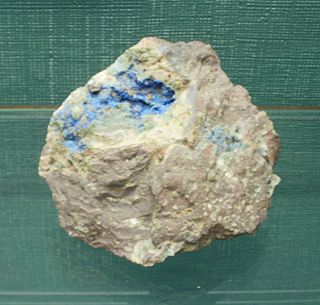 W
WCalumetite is a natural rarely occurring mineral. It was discovered in 1963 at the Centennial Mine near Calumet, Michigan, United States. Calumetite was first discovered along with anthonyite. It has a chemical formula of Cu(OH,Cl)2•2(H2O).
 W
WCarnallite (also carnalite) is an evaporite mineral, a hydrated potassium magnesium chloride with formula KMgCl3·6(H2O). It is variably colored yellow to white, reddish, and sometimes colorless or blue. It is usually massive to fibrous with rare pseudohexagonal orthorhombic crystals. The mineral is deliquescent (absorbs moisture from the surrounding air) and specimens must be stored in an airtight container.
 W
WChallacolloite, KPb2Cl5, is a rare halide mineral. It crystallizes in the monoclinic system and occurs as white fumarolic encrustations on lava. It occurs as intergrowths with cotunnite.
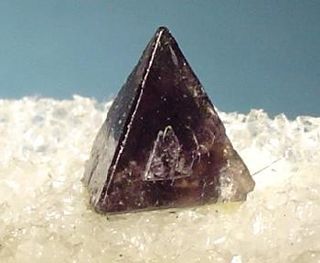 W
WChambersite is a manganese borate mineral with formula: Mn3B7O13Cl. It is a member of the borate mineral series that includes other minerals such as ericaite, Fe3B7O13Cl, and boracite Mg3B7O13Cl. When chambersite was first discovered, it was the second chemical analogue of boracite to be found in nature. It was discovered as a mineral at Barber's Hill salt dome in Texas in 1957 and in 1971 at the Dongshuichang deposit in Jixian, Tianjin, China. Chambersite occurs associated with the evaporite minerals halite, anhydrite, and gypsum.
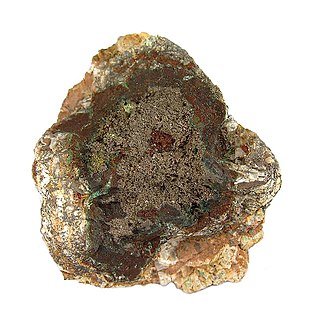 W
WChlorargyrite is the mineral form of silver chloride (AgCl). Chlorargyrite occurs as a secondary mineral phase in the oxidation of silver mineral deposits. It crystallizes in the isometric - hexoctahedral crystal class. Typically massive to columnar in occurrence it also has been found as colorless to variably yellow cubic crystals. The color changes to brown or purple on exposure to light. It is quite soft with a Mohs hardness of 1 to 2 and dense with a specific gravity of 5.55. It is also known as cerargyrite and, when weathered by desert air, as horn silver. Bromian chlorargyrite is also common. Chlorargyrite is water-insoluble.
 W
WChlorophane, also sometimes known as pyroemerald, cobra stone, and pyrosmaragd, is a rare variety of the mineral fluorite with the unusual combined properties of thermoluminescence, thermophosphoresence, triboluminescence, and fluorescence: it will emit light in the visible spectrum when exposed to ultraviolet light, when heated, and when rubbed; if heated, it will continue to emit light for a period of time after a heat source is withdrawn. The small amount of heat generated by being held in the hand has been reported as enough to induce luminiscence, though this may be the result of experimental error. Although chemically very similar to fluorite, chlorophane has several impurities including magnesium, aluminum, manganese, and traces of iron and sodium. As of 2013 it was still not known which if any of these impurities imparts to chlorophane the luminescent properties that distinguish it from fluorite. Some samples of chlorophane, particularly those exposed to high temperatures, will only luminesce once or will do so with only weakened intensity over time. A very bright luminescence can be achieved at between 200 °C (392 °F) and 300 °C (572 °F), and mineralogists once believed that it would glow indefinitely at temperatures of just 30 °C (86 °F), meaning that when exposed on the ground in warmer climates, the mineral would glow year-round. This effect, which was reported many times without having been observed, was eventually attributed in part to a combination of both heat and light acting on the mineral.
 W
WChloroxiphite is a rare olive green to pistacio green lead copper halide mineral with formula: Pb3CuO2Cl2(OH)2.
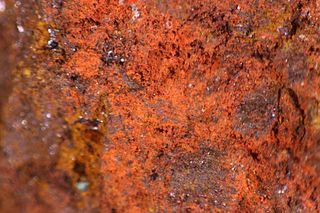 W
WCoccinite is a rare mercury iodide mineral with chemical formula of HgI2, mercury(II) iodide. in addition to its discovery locality of Casas Viejas, Mexico, it has also been reported from Broken Hill, New South Wales, and from a uranium mine in Thuringia and old mercury workings in the Rhineland-Palatinate in Germany. At the Thuringia deposit the mineral occurs as a sublimation product resulting from fires associated with pyrite bearing, graptolitic slate.
 W
WConnellite is a rare mineral species, a hydrous copper chloro-sulfate, Cu19(OH)32(SO4)Cl4·3H2O, crystallizing in the hexagonal system. It occurs as tufts of very delicate acicular crystals of a fine blue color, and is associated with other copper minerals of secondary origin, such as cuprite and malachite. Its occurrence in Cornwall, England, was noted by Philip Rashleigh in 1802, and it was first examined chemically by Prof Arthur Connell FRSE in 1847, after whom it is named.
 W
WCorderoite is an extremely rare mercury sulfide chloride mineral with formula Hg3S2Cl2. It crystallizes in the isometric crystal system. It is soft, 1.5 to 2 on the Mohs scale, and varies in color from light gray to black and rarely pink or yellow.
 W
WCotunnite is the natural mineral form of lead(II) chloride with formula PbCl2.
 W
WDiaboleite is a blue-colored mineral with formula Pb2CuCl2(OH)4. It was discovered in England in 1923 and named diaboleite, from the Greek word διά and boleite, meaning "distinct from boleite". The mineral has since been found in a number of countries.
 W
WHalite, commonly known as rock salt, is a type of salt, the mineral (natural) form of sodium chloride. Halite forms isometric crystals. The mineral is typically colorless or white, but may also be light blue, dark blue, purple, pink, red, orange, yellow or gray depending on inclusion of other materials, impurities, and structural or isotopic abnormalities in the crystals. It commonly occurs with other evaporite deposit minerals such as several of the sulfates, halides, and borates. The name halite is derived from the Ancient Greek word for salt, ἅλς (háls).
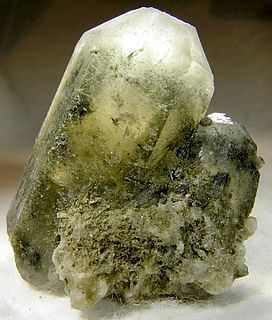 W
WHanksite is a sulfate mineral, distinguished as one of only a handful that contain both carbonate and sulfate ion groups. It has the chemical formula Na22K(SO4)9(CO3)2Cl.
 W
WHerbertsmithite is a mineral with chemical structure ZnCu3(OH)6Cl2. It is named after the mineralogist Herbert Smith (1872–1953) and was first found in 1972 in Chile. It is polymorphous with kapellasite and closely related to paratacamite. Herbertsmithite is generally found in and around Anarak, Iran, hence its other name, anarakite.
 W
WHilgardite is a borate mineral with the chemical formula Ca2B5O9Cl·H2O. It is transparent and has vitreous luster. It is colorless to light pink with a white streak. It is rated 5 on the Mohs Scale. It crystallizes in the triclinic crystal system. Crystals occur as distorted tabular triangles and are hemimorphic, polytypes exist.
 W
WHydrohalite is a mineral that occurs in saturated halite brines at cold temperatures. It was first described in 1847 in Dürrnberg, Austria. It exists in cold weather.
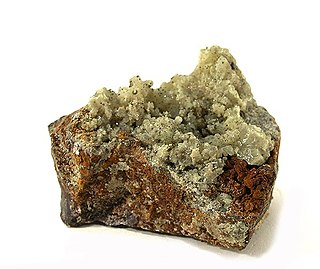 W
WIodyrite or iodargyrite is a natural mineral form of silver iodide.
 W
WKainite ( or ) (KMg(SO4)Cl·3H2O) is an evaporite mineral in the class of "Sulfates (selenates, etc.) with additional anions, with H2O" according to the Nickel–Strunz classification. It is a hydrated potassium-magnesium sulfate-chloride, naturally occurring in irregular granular masses or as crystalline coatings in cavities or fissures. This mineral is dull and soft, and is colored white, yellowish, grey, reddish, or blue to violet. Its name is derived from Greek καινος [kainos] ("(hitherto) unknown"), as it was the first mineral discovered that contained both sulfate and chloride as anions. Kainite forms monoclinic crystals.
 W
WKremersite is a rare mineral which is a hydrated multiple chloride of iron, ammonium and potassium with the formula: (NH4,K)2FeCl5·H2O. Kremersite is a brown-red to orange mineral that crystallizes in the orthorhombic system. It is a water-soluble mineral that is found around volcanic fumaroles. Occurs at Vesuvius, Italy and Mount Etna, Sicily. It was discovered in 1853 and named for the German chemist, Peter Kremers (born 1827).
 W
WLaurionite is a lead halide mineral. It forms colorless to white crystals in the orthorhombic crystal system and is dimorphous with paralaurionite, both members of the matlockite group.
 W
WMarialite is a silicate mineral with a chemical composition of Na4Al3Si9O24Cl if a pure endmember or Na4(AlSi3O8)3(Cl2,CO3,SO4) with increasing meionite content. Marialite is a member of the scapolite group and a solid solution exists between marialite and meionite, the calcium endmember. It is a rare mineral usually used as a collector's stone. It has a very rare but attractive gemstones and cat's eye.
 W
WMarshite (CuI) is a naturally occurring isometric halide mineral with occasional silver (Ag) substitution for copper (Cu). Solid solution between the silver end-member miersite and the copper end-member marshite has been found in these minerals from deposits in Broken Hill, Australia. The mineral’s name is derived from the person who first described it, an Australian mineral collector named Charles W. Marsh. Marsh drew attention to native copper iodide (Marshite) in the 1800s emphasizing its natural occurrence, it is not to be confused with copper (I) iodide a substance commonly synthesized in laboratory settings.
 W
WMatlockite is a rare lead halide mineral, named after the town of Matlock in Derbyshire, England, where it was first discovered in a nearby mine. Matlockite gives its name to the matlockite group which consists of rare minerals of a similar structure.
 W
WMendipite is a rare mineral that was named in 1939 for the locality where it is found, the Mendip Hills in Somerset, England. It is an oxyhalide of lead with formula Pb3Cl2O2.
 W
WMimetite, whose name derives from the Greek Μιμητής mimetes, meaning "imitator", is a lead arsenate chloride mineral (Pb5(AsO4)3Cl) which forms as a secondary mineral in lead deposits, usually by the oxidation of galena and arsenopyrite. The name is a reference to mimetite's resemblance to the mineral pyromorphite. This resemblance is not coincidental, as mimetite forms a mineral series with pyromorphite (Pb5(PO4)3Cl) and with vanadinite (Pb5(VO4)3Cl). Notable occurrences are Mapimi, Durango, Mexico and Tsumeb, Namibia.
 W
WNadorite is a mineral with the chemical formula PbSbO2Cl. It crystallizes in the orthorhombic crystal system and is brown, brownish-yellow or yellow in color, with a white or yellowish-white streak.
 W
WParalaurionite is a colorless mineral consisting of a basic lead chloride PbCl(OH) that is dimorphous with laurionite. It is a member of the matlockite group. The name is derived from para-, the Greek for "near", and laurionite, because of its polymorphic relationship to it. Bright, yellow tips of thorikosite can form on paralaurionite crystals and paralaurionite may also be intergrown with mendipite.
 W
WParatacamite is a mineral in the halide minerals category. Its chemical formula is Cu3(Cu,Zn)(OH)6Cl2. Its name is derived from its association with atacamite.
 W
WPerite is a mineral that has a general chemical formula of PbBiO2Cl. The name is given for Per Adolf Geijer, a Swedish economic geologist with the Geological Survey of Sweden, who discovered the mineral in 1960 outside of Langban, Sweden. Perite is orthorhombic, which means crystallographically, it contains three axes of two of equal length (the bases a and b) and one of a little longer or shorter length. All three bases intersect at a 90° angles. It belongs to the space group Cmcm {C2/m 2/c 21/m}. In terms of its optical properties, Perite is anisotropic which means the velocity of light varies depending on direction through the mineral (i.e. it is birefringent). Its calculated relief is 1.45-1.461, which is moderate. It is colorless in plane polarized light, and it is weakly pleochroic. Perite is found in areas near igneous extrusions in places like the Western United States, Southern Australia, and scattered around Europe.
 W
WPhosgenite is a rare mineral consisting of lead chlorocarbonate, (PbCl)2CO3. The tetragonal crystals are prismatic or tabular in habit: they are usually colorless and transparent, and have a brilliant adamantine lustre. Sometimes the crystals have a curious helical twist about the tetrad or principal axis. The hardness is 3 and the specific gravity 6.3. The mineral is rather sectile, and consequently was earlier known as corneous lead, (German Hornblei).
 W
WPyromorphite is a mineral species composed of lead chlorophosphate: Pb5(PO4)3Cl, sometimes occurring in sufficient abundance to be mined as an ore of lead. Crystals are common, and have the form of a hexagonal prism terminated by the basal planes, sometimes combined with narrow faces of a hexagonal pyramid. Crystals with a barrel-like curvature are not uncommon. Globular and reniform masses are also found. It is part of a series with two other minerals: mimetite (Pb5(AsO4)3Cl) and vanadinite (Pb5(VO4)3Cl), the resemblance in external characters is so close that, as a rule, it is only possible to distinguish between them by chemical tests. They were formerly confused under the names green lead ore and brown lead ore (German: Grünbleierz and Braunbleierz).
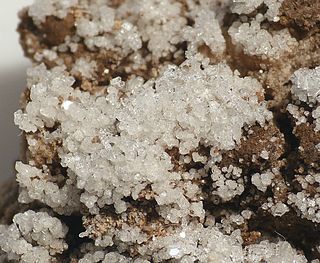 W
WSalammoniac, also sal ammoniac or salmiac, is a rare naturally occurring mineral composed of ammonium chloride, NH4Cl. It forms colorless, white, or yellow-brown crystals in the isometric-hexoctahedral class. It has very poor cleavage and is brittle to conchoidal fracture. It is quite soft, with a Mohs hardness of 1.5 to 2, and it has a low specific gravity of 1.5. It is water-soluble. Sal ammoniac is also the archaic name for the chemical compound ammonium chloride.
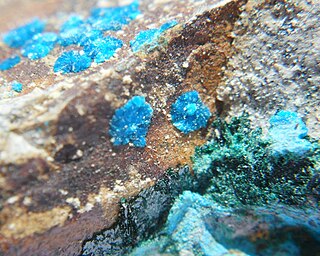 W
WSampleite has a general formula of NaCaCu5(PO4)4Cl•5(H2O). It was first described in 1942 for an occurrence in Chuquicamata, Chile and was named after Mat Sample, a mine superintendent for the Chile Exploration Company.
 W
WSodalite is a rich royal blue tectosilicate mineral with the formula Na8(Al6Si6O24)Cl2, widely used as an ornamental gemstone. Although massive sodalite samples are opaque, crystals are usually transparent to translucent. Sodalite is a member of the sodalite group with hauyne, nosean, lazurite and tugtupite.
 W
WSylvite, or sylvine, is potassium chloride (KCl) in natural mineral form. It forms crystals in the isometric system very similar to normal rock salt, halite (NaCl). The two are, in fact, isomorphous. Sylvite is colorless to white with shades of yellow and red due to inclusions. It has a Mohs hardness of 2.5 and a specific gravity of 1.99. It has a refractive index of 1.4903. Sylvite has a salty taste with a distinct bitterness.
 W
WTerlinguaite is the naturally occurring mineral with formula Hg2ClO. It is formed by the weathering of other mercury-containing minerals. It was discovered in 1900 in the Terlingua District of Brewster County, Texas, for which it is named. Its color is yellow, greenish yellow, brown, or olive green.
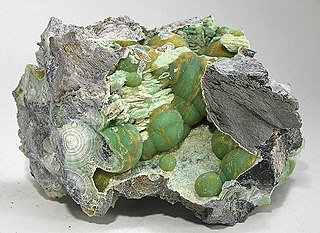 W
WWavellite is an aluminium basic phosphate mineral with formula Al3(PO4)2(OH, F)3·5H2O. Distinct crystals are rare, and it normally occurs as translucent green radial or spherical clusters.
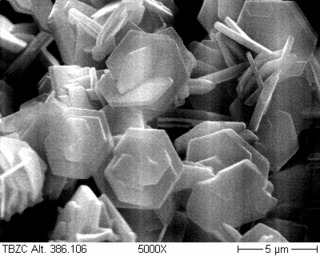 W
WZinc chloride hydroxide monohydrate is a zinc hydroxy compound with chemical formula Zn5(OH)8Cl2·H2O. It is often referred to as tetrabasic zinc chloride (TBZC), basic zinc chloride, zinc hydroxychloride, or zinc oxychloride. It is a colorless crystalline solid insoluble in water. Its naturally occurring form, simonkolleite, has been shown to be a desirable nutritional supplement for animals.
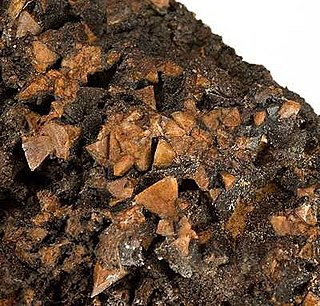 W
WZunyite is a sorosilicate mineral, Al13Si5O20(OH,F)18Cl, composed of aluminium, silicon, hydrogen, chlorine, oxygen, and fluorine.
 W
W